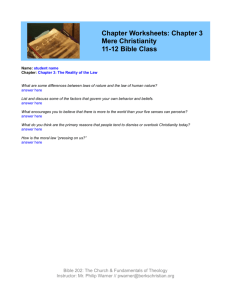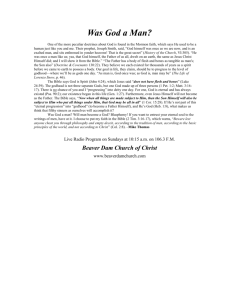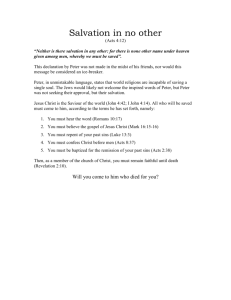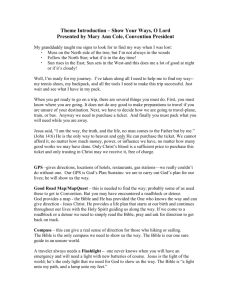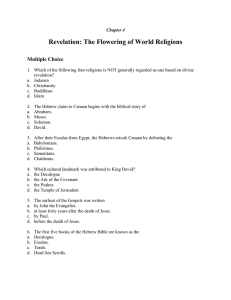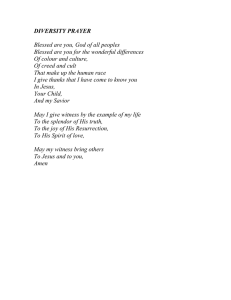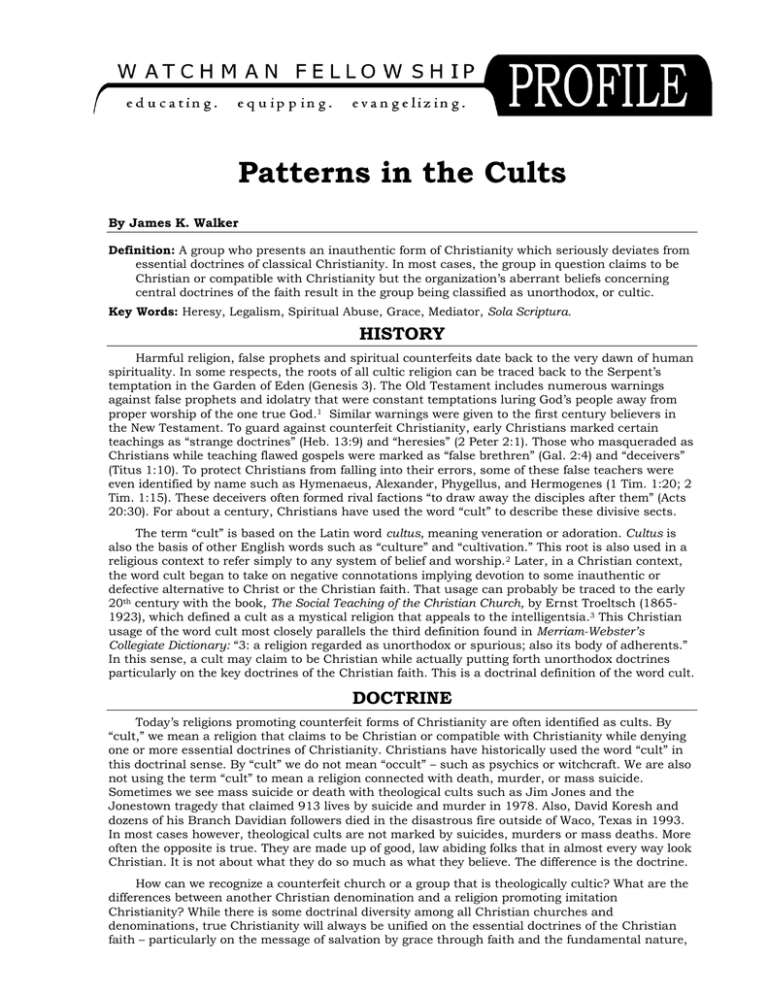
Patterns in the Cults
By James K. Walker
Definition: A group who presents an inauthentic form of Christianity which seriously deviates from
essential doctrines of classical Christianity. In most cases, the group in question claims to be
Christian or compatible with Christianity but the organization’s aberrant beliefs concerning
central doctrines of the faith result in the group being classified as unorthodox, or cultic.
Key Words: Heresy, Legalism, Spiritual Abuse, Grace, Mediator, Sola Scriptura.
HISTORY
Harmful religion, false prophets and spiritual counterfeits date back to the very dawn of human
spirituality. In some respects, the roots of all cultic religion can be traced back to the Serpent’s
temptation in the Garden of Eden (Genesis 3). The Old Testament includes numerous warnings
against false prophets and idolatry that were constant temptations luring God’s people away from
proper worship of the one true God.1 Similar warnings were given to the first century believers in
the New Testament. To guard against counterfeit Christianity, early Christians marked certain
teachings as “strange doctrines” (Heb. 13:9) and “heresies” (2 Peter 2:1). Those who masqueraded as
Christians while teaching flawed gospels were marked as “false brethren” (Gal. 2:4) and “deceivers”
(Titus 1:10). To protect Christians from falling into their errors, some of these false teachers were
even identified by name such as Hymenaeus, Alexander, Phygellus, and Hermogenes (1 Tim. 1:20; 2
Tim. 1:15). These deceivers often formed rival factions “to draw away the disciples after them” (Acts
20:30). For about a century, Christians have used the word “cult” to describe these divisive sects.
The term “cult” is based on the Latin word cultus, meaning veneration or adoration. Cultus is
also the basis of other English words such as “culture” and “cultivation.” This root is also used in a
religious context to refer simply to any system of belief and worship. 2 Later, in a Christian context,
the word cult began to take on negative connotations implying devotion to some inauthentic or
defective alternative to Christ or the Christian faith. That usage can probably be traced to the early
20th century with the book, The Social Teaching of the Christian Church, by Ernst Troeltsch (18651923), which defined a cult as a mystical religion that appeals to the intelligentsia.3 This Christian
usage of the word cult most closely parallels the third definition found in Merriam-Webster’s
Collegiate Dictionary: “3: a religion regarded as unorthodox or spurious; also its body of adherents.”
In this sense, a cult may claim to be Christian while actually putting forth unorthodox doctrines
particularly on the key doctrines of the Christian faith. This is a doctrinal definition of the word cult.
DOCTRINE
Today’s religions promoting counterfeit forms of Christianity are often identified as cults. By
“cult,” we mean a religion that claims to be Christian or compatible with Christianity while denying
one or more essential doctrines of Christianity. Christians have historically used the word “cult” in
this doctrinal sense. By “cult” we do not mean “occult” – such as psychics or witchcraft. We are also
not using the term “cult” to mean a religion connected with death, murder, or mass suicide.
Sometimes we see mass suicide or death with theological cults such as Jim Jones and the
Jonestown tragedy that claimed 913 lives by suicide and murder in 1978. Also, David Koresh and
dozens of his Branch Davidian followers died in the disastrous fire outside of Waco, Texas in 1993.
In most cases however, theological cults are not marked by suicides, murders or mass deaths. More
often the opposite is true. They are made up of good, law abiding folks that in almost every way look
Christian. It is not about what they do so much as what they believe. The difference is the doctrine.
How can we recognize a counterfeit church or a group that is theologically cultic? What are the
differences between another Christian denomination and a religion promoting imitation
Christianity? While there is some doctrinal diversity among all Christian churches and
denominations, true Christianity will always be unified on the essential doctrines of the Christian
faith – particularly on the message of salvation by grace through faith and the fundamental nature,
attributes, and identity of God. A cult of Christianity, however, will usually look Christian to the
casual observer. They will self-identify as Christian and may be composed of good people doing good
works and using Christian vocabulary. Nevertheless, a theological cult of Christianity will depart
from one or more of the essential doctrines of the faith. To help recognize these doctrinal errors,
Watchman Fellowship has developed four patterns or marks commonly found in cults. To make it
memorable, we use the four functions of math: Addition, Subtraction, Multiplication, and Division. 4
Add to God’s Word
The first doctrinal pattern found in most cults is Addition. One should always ask the question,
“Does the religion add to God’s word with new Scripture?” While almost every pseudo-Christian
group will use the Bible in some fashion, they will usually say that the Bible contains serious errors
or is not sufficient and must be supplemented by the cults own words. They do this in three ways:
1. Some add to Scripture new, inspired “revelations” from God (e.g., the apocalyptic revelations
of David Koresh of the Branch Davidians).
2. Others add to Scripture by declaring that the Bible cannot be understood apart from the
indispensable literature or teachings of their group (e.g., the reliance of Jehovah’s Witnesses
upon literature from the Watchtower Society).
3. Others actually insert additional books to the canon (e.g., the Book of Mormon).
In each case, the sects’ leaders appear to endorse the Bible as a good, helpful book. They warn,
however, that the Bible is not a sufficient guide to God’s truth because it is incomplete, has been
altered, or is impossible to understand by itself. Thus, they must add to it.
In his Articles of Faith, Joseph Smith said “We believe the Bible to be the word of God as far as
it is translated correctly; we also believe the Book of Mormon to be the word of God.” Smith added, “I
told the brethren that the Book of Mormon was the most correct of any book on earth… a man
would get nearer to God by abiding by its precepts, than by any other book.” 5
Charles Russell, founder of the Watchtower Bible and Tract Society, warned that if anyone
stopped reading his Watchtower publications and “ignores them and goes to the Bible alone,… our
experience shows that within two years he goes into darkness.” He explained it would have been
better if they had “not read a page of the Bible, as such.”6
God’s prohibition against adding to His word is clearly set out in the Old Testament: “You shall
not add to the word which I command you, nor take from it…” (Deut. 4:2). Obviously, this command
does not rule out future revelation from God since He gave us the rest of the Old Testament as well
as the New. God is specifically warning that people are not to add to His word anything that is not
His word. The same warning is repeated again in the final book of the Bible (Rev. 22:18).
The first “mark” of a cult, addition, addresses the issue of authority. Evangelical Christianity is
committed to the principle of sola scriptura, which maintains that the Bible alone contains all
knowledge necessary for salvation and holiness. Once that principle is abandoned and the Bible is
no longer the ultimate authority, the cult’s leaders are free to supersede the scriptures with their
own proclamations, prophecies, revelations, or essential writings. Thus, the group is vulnerable to
succumb to the other three patterns in the cults: Subtract, Multiply, and Divide.
Subtract from Jesus
Christians may differ on secondary issues such as the spiritual gifts, eschatology (end-times),
and church government but they always agree on the fundamentals of the faith. One of those
fundamentals is the identity of Jesus Christ. One can be wrong on secondary doctrines and still be
a Christian. Anyone who puts their faith in a counterfeit Christ, however, is a victim of a deadly case
of mistaken identity. The question must be asked, “Does the religion subtract from Jesus?”
Few religions that claim to be Christian will be openly disrespectful of Jesus. Even patently
non-Christian religions will often honor Jesus as a great teacher or prophet. Nevertheless, both nonChristian religions and cults that claim to be Christian will characteristically subtract from some
essential aspect of Christ’s nature. Most false teachers will subtract from either the humanity or
deity of Christ. The resulting “Jesus” is a cheap imitation of the true Christ presented in the
Scriptures as fully God and fully man (John 1:1; 1 Tim. 2:5). This is not new. In the first century,
there were false teachers preaching “another Jesus whom we have not preached” (2 Cor. 11:4).
An obvious contemporary example of subtracting from Jesus is the Florida-based Cresciendo
en Gracia (Growing in Grace) lead by José Luis de Jesús Miranda.7 This religion, which claims to
have two million followers in 130 countries, subtracts from Jesus by claiming their founder,
Miranda, is actually the second coming of Christ. In fact, he claims he is both the Christ and the
Antichrist even tattooing the numbers 666 on his arm. Like Miranda, the late Rev. Sun Myung Moon
was revered by his followers as the second coming of Christ. Additional examples of subtracting
from Jesus include the Watchtower Bible and Tract Society which insists that Jesus was never God
but a manifestation of the archangel Michael who died on a stake and never rose bodily from the
dead. Mormonism teaches that Jesus is not the uniquely begotten Son of God but one of billions of
spirit children of Heavenly Father and Heavenly Mother.8
This second “mark” of a cult, subtraction, addresses the identity of Jesus Christ. Virtually all
religions claim to believe in Jesus. Most believe that He existed, was a great man, and did many
good works. But Jesus never asked His followers, “Do people believe I exist?” Christ’s question was
“Who do men say that I, the Son of Man, am?” (Matt. 16:13). Christianity is historically grounded on
the biblical doctrine of God in three Persons – blessed Trinity.9 As the second Person of the Trinity,
Jesus Christ is to be honored as the eternal God made flesh – fully God and fully man. Anything
less is a subtraction from Jesus which leads to the other two marks of a cult – Multiply, and Divide.
Multiply the Requirements for Salvation
The third pattern is Multiplication. Does the religion multiply the requirements of salvation?
Cults teach the first mathematical formula below: Salvation comes through faith plus good works.
The Bible, however, teaches that we are not saved by our works. We are saved by the work of Christ
on the cross – His death, burial and resurrection – not by anything we do to earn or merit
forgiveness (Titus 3:4-6). If we add even one work to grace it is no longer grace (Rom. 11:5-6).
Faith + Works = Salvation (WRONG)
Faith = Salvation + Works (RIGHT)
The second mathematical formula presents a biblical view: Saving faith in Christ equals
salvation (eternal life) plus a changed life (works). False teachers say one must do good works in
order to be saved. True Christianity teaches we do good works because we are saved (Titus 2:11-14).
The International Churches of Christ (ICC), a radical break-off of the traditional Churches of
Christ, teach that water baptism plus commitment to daily discipleship are requirements for
salvation. They teach “SAVED=CHRISTIAN=DISCIPLE, simply meaning that you cannot be saved
and you cannot be a true Christian without being a disciple also…. [O]ne must make the decision to
be a disciple, then be baptized for the forgiveness of their sins to be saved….”10 They define
discipleship as having daily contact with an ICC assigned “discipleship partner” who, according to
former members, may exercise inappropriate control over virtually every aspect of their disciple’s
life. Every discipler in turn has a discipler over him forming a pyramid of authority in each church.
Similarly, each Jehovah’s Witnesses is taught that salvation requires making “changes in their
life in order to meet the requirements for becoming subjects of God’s government.” These required
changes include a commitment to regularly go door-to-door distributing Watchtower publications
thus becoming one of the “loyal spokesmen or proclaimers of God’s kingdom.”11
The Philadelphia Church of God is one of many splinter-groups of the now-defunct Worldwide
Church of God founded by Herbert Armstrong. Their gospel of legalism teaches salvation by works
not grace. One must tithe and keep Old Testament dietary laws (no pork or shell fish) to be saved.”12
The third “mark” of a cult, multiplication, addresses the doctrine of salvation and forgiveness of
sin. It answers the question asked by the Philippian jailer, “What must I do to be saved?” The
answer, “Believe on the Lord Jesus Christ, and you will be saved, you and your household.” (Acts
16:30-31). Evangelical Christianity embraces the biblical doctrine of salvation by God’s grace
through faith in Christ alone (Eph. 2:8-10). Any mixture of faith plus human merit becomes a works
gospel. This multiplies the requirements of salvation and leads to the final cult pattern – Division.
Divide the Followers’ Loyalties
Which church saves? Of course, no church or religious organization can grant forgiveness of sins or
salvation. Only Jesus can save. But what about churches or religious leaders who teach that Jesus
can only provide salvation through their organization? The fourth and final mark is division. One
should ask the question, “Does the religion DIVIDE their followers’ loyalties by saying that you
cannot be loyal to God unless you are loyal to their group?” The Bible tells us to “Reject a divisive
man after the first and second admonition” (Titus 3:10). The Greek word translated “divisive” is the
source of the English word “heresy” which means “a choosing, choice… a self-willed opinion, which
is substituted for submission to the power of truth, and leads to division and the formation of
sects.”13 A heresy is a false teaching involving an essential doctrine of the Christian faith. Once a
heresy becomes organized, you have the makings of a cult.
Cults teach that their religion represents the only true church and there is no salvation outside
of their group. They are, in effect, the only officially sanctioned distributers of eternal life. To get to
heaven, it seems, one must go through Salt Lake City, Brooklyn, Washington or wherever they are
headquartered. Jehovah’s Witnesses are told, “…now the witness yet includes the invitation to come
to Jehovah’s organization for salvation.” Mormonism’s founder, Joseph Smith, claimed that Jesus
told him not to join any of the existing churches on earth because “they were all wrong; and… that
all their creeds were an abomination in his sight.” Because every existing church in 1820 was false,
Joseph Smith claimed to organize the “only true and living church upon the face of the earth.” 14
Cult members will endure a tremendous amount of spiritual abuse if they are convinced there
is no salvation outside of their organization. An extreme example of this was seen in 1993 outside
Waco, Texas during the 51-day standoff between federal law enforcement and cult leader David
Koresh of the Branch Davidians. Koresh told officials that he had given every Davidian the
opportunity to turn themselves in and to safely leave the compound but the remnant had decided
instead to remain inside and take their chances. According to Brian Sage of the FBI, Koresh had
really told each Branch Davidian, “You’re free to go, but you need to realize that if you leave, you're
leaving your eternal salvation here and you're going out to the beast. But that's your decision.
You're free to go.”15 Very few left because Koresh convinced them there was no salvation outside the
compound. Days later, 75 Branch Davidians died in a horrible fire. Even as the flames began to
spread and death was imminent, no one fled and no one escaped. Koresh had successfully divided
his followers’ loyalties convincing them they could not be loyal to God without remaining with him.
This fourth pattern of a cult, division, violates the biblical principle that clearly teaches Jesus is
the sole mediator between humanity and deity. In a sense, the cult leader steps between God and
his people saying that the only way to get to God is through him. This divides his followers’ loyalties
and separates them from Christ – the only true mediator. The Bible is clear, “For there is one God,
and one mediator between God and men, the man Christ Jesus” (1 Tim. 2:5).
Christians should remember that people involved in cults are not their enemies. They are
victims of false teachings that reject essential doctrines of the faith. True Christians should pray for
them, be committed to reach them with the true gospel by “speaking the truth in love” (Eph. 4:15),
and become equipped to answer their questions with gentleness and respect (1 Peter 3:15).
Notes
Deut. 4:15-29; 13:1-4; 18:20-22; Lev. 20:2-5; Jer. 32:35.
Christianity,” Jason Barker, “The Watchtower Bible and Tract Society,
2 In the last 50 years, the term cult has also been evolving in the
and Tim Martin, “The Church of Jesus Christ of Latter-day Saints,”
works of psychologists, sociologists and anthropologists who use the
Profile Notebook (Arlington, Texas: Watchman Fellowship, Inc. 1994term to describe religious communities with meanings (some non2013). Profile Notebooks are available at
1 Deut. 4:15-29; 13:1-4; 18:20-22; Lev. 20:2-5; Jer. 32:35.
pejorative)
that are unique to their disciplines. They are usually
http://www.watchman.org/notebook.
2 In the last 50 years, the term cult has also been evolving in the works of psychologists, sociologists and anthropologists who frequently use the term to describe certain types of religious
focused
either
on
the
group’s
assimilation
into
the
larger
culture
or
9 While
thedoctrines
word “Trinity”
is not
found
Bible,
the doctrine is
communities with meanings (some non-pejorative) that are unique to their disciplines. They do not consider
the group’s
but are usually
focused
either in
on the
the group’s
assimilation
into
larger cultureor
or abusive
possible unhealthy
abusive group behavior.
onthe
unhealthy
group or
behavior.
biblical.
The Trinity doctrine teaches that there is only one true God
3 Ernst Troeltsch, Die Soziallehren der christlichen Kirchen und Gruppen. Tubingen: Verlag von J. C. B. Mohr, 1912 (English translation 1931). See: The Concise Evangelical Dictionary of
3 Ernst Troeltsch, Die Soziallehren der christlichen Kirchen und
eternally existing as three distinct Persons. The Father, Son, and Holy
Theology, s. v. “Cults.”
Gruppen.
4 This is anTubingen:
Verlag
von J.
C. B. Mohr,
1912
(English
updated edition
of the Profile
Watchman
Fellowship
first published
in 1994. The “mathematical
formula”
of add,
subtract,
multiply, For
and divide
was first developed
by supporting
John
Spirit are
coequal
and
coeternal.
a scriptural
outline
Whaley
of
Watchman
Fellowship
in
the
late
1980s.
In
2005,
the
Apologetic
Group
in
partnership
with
Watchman Fellowship and other ministries produced a 117 minute video documentary
translation 1931). See: The Concise Evangelical Dictionary of
the
Trinity doctrine, see our article “Biblical Basis for Trinity,”
using the same mathematical formula. This video documentary is available at http://www.watchman.org/store/cults-alternative-religions/audio/cult-biblical-analysis/.
Theology,
v. “Cults.”
5 Article 8, s.
http://www.watchman.org/articles/general-topics-doctrine/biblicalhttp://mormon.org/beliefs/articles-of-faith.
Book of Mormon (Introduction), http://www.lds.org/scriptures/bofm/introduction.
4 This
6 The
Watch
Sept. 15, 1910,
p. 298.
isTower,
an updated
edition
of the Profile Watchman Fellowship
basis-for-trinity.
7 A separate Profile has been published on Growing in Grace: James Walker, “José Luis de Jesús Miranda” Profile Notebook, Watchman Fellowship, Inc. (Arlington, Texas: 1994-2013). A
first published in 1994. The “mathematical formula” was first
10 Kip McKean, “Revolution Through Restoration,” Upside Down,
complete Profile Notebook (over 400 pages) is available at http://www.watchman.org/Notebook.
developed
by John
of Watchman
Fellowship
in“Holy
the Spirit
late Association for
8 Separate Profiles
have Whaley
been published
on these religions:
Rick Branch,
the Unification
of World
Christianity,” Jason Barker, “The Watchtower Bible and Tract
Issue
2, 1992,
pp. 7-8.
Society,
andIn
Tim
Martin,the
“The Apologetic
Church of Jesus
Christ of
Saints,”with
Profile Watchman
Notebook (Arlington, Texas:
Watchman Fellowship, Inc. 1994-2013). Profile Notebooks are available at
1980s.
2005,
Group
inLatter-day
partnership
11 You
Can Live Forever in Paradise on Earth, pp. 132-33.
http://www.watchman.org/notebook.
Fellowship
and“Trinity”
otherisministries
produced
a video
documentary
12that
9 While the word
Forthere
more
information
on these
religions,
see the
four-page
not found in the
Bible, the doctrine
is biblical.
The Trinity doctrine teaches
is only
one true God eternally
existing
as three distinct
Persons.
The
Father,
and
Holy Spirit
are coequal and
coeternal. available
For a scriptural
doctrine, see
our article
“Biblical
Basis for Trinity,”
usingSon,
the
same
mathematical
formula
at outline supporting the TrinityProfiles:
Phillip
Arnn,
“Armstrongism;”
Tim Martin, “Philadelphia
http://www.watchman.org/articles/general-topics-doctrine/biblical-basis-for-trinity.
http://www.watchman.org/store/cults-alternativeChurch of God;” and Jason Barker, “Watchtower Bible and Tract
10 Kip McKean, “Revolution Through Restoration,” Upside Down, Issue 2, 1992, pp. 7-8.
religions/audio/cult-biblical-analysis/.
11 You Can Live Forever in Paradise on Earth, pp. 132-33.
Society.” Profile Notebook (Arlington, Texas: Watchman Fellowship, Inc.
125For more information on these religions, see the four-page Profiles: Phillip Arnn, “Armstrongism;” Tim Martin, “Philadelphia Church of God;” and Jason Barker, “Watchtower Bible and
Article 8, http://mormon.org/beliefs/articles-of-faith. Book of
1994-2013). Profile Notebooks are available at
Tract Society.” Profile Notebook (Arlington, Texas: Watchman Fellowship, Inc. 1994-2013). Profile Notebooks are available at http://www.watchman.org/notebook.
Mormon
(Intro.),Dictionary
http://www.lds.org/scriptures/bofm/introduction.
13 Vine’s Expositor
http://www.watchman.org/notebook.
of New Testament Words.
146The
Watchtower,
Nov. 15, 1981,
p. 21;
First Vision” (http://www.lds.org/library/display/0,4945,104-1-3-4,00.html.
Boyd K.ofPackard,
“The Only TrueWords.
Church,” General
The
Watch Tower,
Sept.
15,“Joseph
1910,Smith’s
p. 298.
13 Vine’s Expositor Dictionary
New Testament
Conference,
Oct. 1985; https://www.lds.org/general-conference/1985/10/the-only-true-church?lang=eng.
7 A separate
Profile
has
been
published
on
Growing
in
Grace:
14 The Watchtower, Nov. 15, 1981, p. 21; “Joseph Smith’s First
15 “Waco: the Inside Story,” PBS Frontline, Oct. 17, 1995: http://www.pbs.org/wgbh/pages/frontline/waco/wacotranscript.html.
James Walker, “José Luis de Jesús Miranda” Profile Notebook,
Vision” (http://www.lds.org/library/display/0,4945,104-1-3Watchman Fellowship, Inc. (Arlington, Texas: 1994-2013). A
4,00.html. Boyd K. Packard, “The Only True Church,” General
complete Profile Notebook (over 400 pages) is available at
Conference, Oct. 1985; https://www.lds.org/generalhttp://www.watchman.org/Notebook.
conference/1985/10/the-only-true-church?lang=eng.
8 Separate Profiles have been published on these religions: Rick
15 “Waco: the Inside Story,” PBS Frontline, Oct. 17, 1995:
Branch, “Holy Spirit Association for the Unification of World
http://www.pbs.org/wgbh/pages/frontline/waco/wacotranscript.html
1
Profile is a regular publication of Watchman Fellowship, Inc. Readers are encouraged to begin their
own religious research notebooks using these articles. Profiles are published by Watchman Fellowship
approximately 6 times per year, covering subjects such as new religious movements, counterfeit
Christianity, the occult, New Age Spirituality, and related doctrines and practices. Complete Profile
Notebooks containing all Profiles published to date are available. Please contact Watchman Fellowship
for current pricing and availability. Copyright © 2013 by Watchman Fellowship. All rights reserved.


